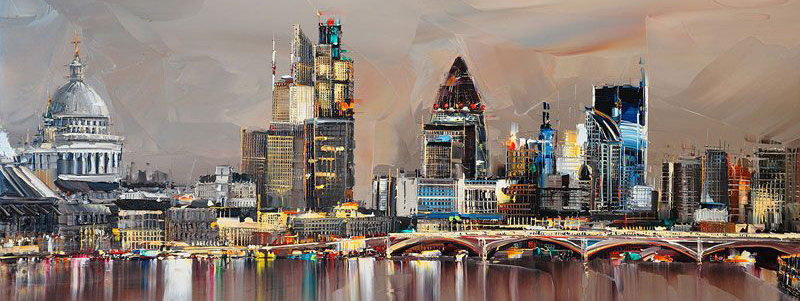Embankment - ST James's
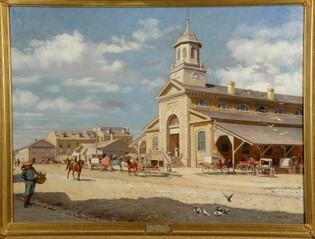 The name Covent Garden derives from the use that was made of this area, namely a garden for the abbey of St Paul's. The expression convent garden contracted to become covent. The name garden then came to signify the market of orchard products which would take place there, of which there are still many traces. The doors of what were once warehouses, for example, are very tall. Also still present today, in many spots, are lifting winches, which have been restored and become an object of design. Today Covent Garden is a tourist attraction with many pubs and restaurants, artisan shops and organic food, as well as ethnic stores, bookshops, and art galleries.
The name Covent Garden derives from the use that was made of this area, namely a garden for the abbey of St Paul's. The expression convent garden contracted to become covent. The name garden then came to signify the market of orchard products which would take place there, of which there are still many traces. The doors of what were once warehouses, for example, are very tall. Also still present today, in many spots, are lifting winches, which have been restored and become an object of design. Today Covent Garden is a tourist attraction with many pubs and restaurants, artisan shops and organic food, as well as ethnic stores, bookshops, and art galleries.In order to build the square, the architect Inigo Jones used the square in Livorno (or Leghorn) as a model, after the work of transformation undertaken under the auspices of Ferdinando de' Medici, who had become the duke of Tuscany in 1587. At the time, Livorno was an international port, with a great square and a cathedral. Inigo Jones, assigned with tasks by the duke of Bedford, had seen them at the end of the Sixteenth Century during his visit in Italy, and had decided to include a church and two lines of colonnades at the sides, with some houses bearing elegant facades. Unfortunately, of such project, only a few houses were left standing.
Those between numbers 1 and 8 of Godwin's Court, for example, have remained unchanged since the beginning of the XVIII Century. Walking through this short but utterly beautiful street, where the Theatre Goers Club stands, gives one the impression of being hurled back in time. Upon the black shiny doors are bronze knockers, and just in front stand some large gas lamps. The wide bow windows tell the tale of these ground floor rooms, which once used to belong to shops. A plaque reveals that, in the past, this street was known as Fishers Alley.
At number 90 of the adjoining St Martin's Lane, we can find the Salisbury Pub, with its beautiful Victorian insides, its mirrors and decorations of a time gone by, where one can enjoy a glass of wine or a pint of beer.
UNDERGROUND: COVENT GARDEN
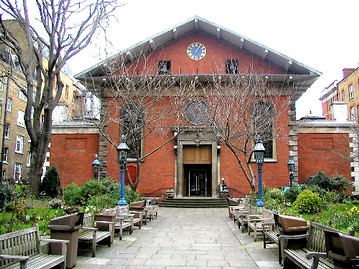 The church of St Paul, which stands on the Western side of the square, is known as "the actors' church", due to its close relationship with the two nearby theatres, the Royal Opera House and the Theatre Royal. On the walls, many plaques have been affixed, with the names of actors, playwrights, and illustrators, who would once come here to the services, and whose ashes rest inside the niches within. Amongst them, is the theatre actress Ellen Terry, a great Shakespearean performer, who started acting on stage as a child, and Ivor Novello, the Welsh actor and composer who was very famous after the war for his interpretations of musical comedies.
The church of St Paul, which stands on the Western side of the square, is known as "the actors' church", due to its close relationship with the two nearby theatres, the Royal Opera House and the Theatre Royal. On the walls, many plaques have been affixed, with the names of actors, playwrights, and illustrators, who would once come here to the services, and whose ashes rest inside the niches within. Amongst them, is the theatre actress Ellen Terry, a great Shakespearean performer, who started acting on stage as a child, and Ivor Novello, the Welsh actor and composer who was very famous after the war for his interpretations of musical comedies.The client, namely the duke of Bedford, had told the architect that he did not wish to spend too much on the religious building, having already invested great part of his wealth on rebuilding the square. Therefore the church could not become much more than a granary. "In that case, Sir, you shall have the finest granary in England!", was Inigo Jones' reply. The house at number 43, King Street, built in 1716 for the admiral Russell, was the first to alter the style, until then mostly uniform, of the facades. Since then, little by little, the original design has been gradually abandoned. The original building of the church was destroyed in a fire in 1795, and the entrance is now at the back. One must cross a small graveyard, which in actual fact is a wonderful garden, where, as early as 1665, victims of the Plague used to be buried. The first of them was Margaret Ponteous, the daughter of a doctor. There are many benches underneath the cherry trees, which flower during the months of May and June. Often there are conservatory students playing classical music on the flute or violin.
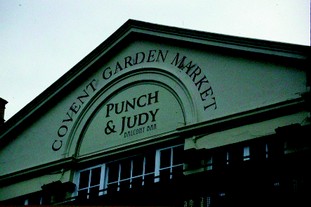 The colonnade of Pygmalion and Pulcinella - Today actors and street musicians perform in front of the church or under its colonnade. On 9th May 1662, Samuel Pepys wrote in his Diary that the first Italian Puppet Play had taken place under the colonnade. This is the first annotation we have regarding the Punch and Judy Show, which is commemorated every year at the May Fayre. Inside the church, concerts of chamber music are held. The first scene of the comedy Pygmalion by George Bernard Shaw - later adapted and transformed into the musical My Fair Lady - namely the encounter between Higgins and the female florist, is set precisely beneath this colonnade.
The colonnade of Pygmalion and Pulcinella - Today actors and street musicians perform in front of the church or under its colonnade. On 9th May 1662, Samuel Pepys wrote in his Diary that the first Italian Puppet Play had taken place under the colonnade. This is the first annotation we have regarding the Punch and Judy Show, which is commemorated every year at the May Fayre. Inside the church, concerts of chamber music are held. The first scene of the comedy Pygmalion by George Bernard Shaw - later adapted and transformed into the musical My Fair Lady - namely the encounter between Higgins and the female florist, is set precisely beneath this colonnade. 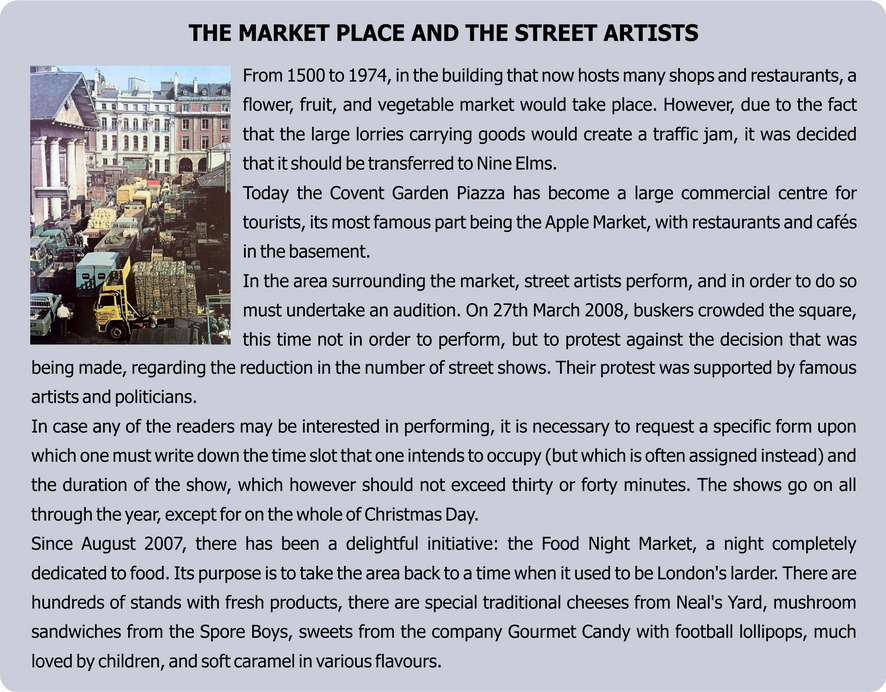
THE LONDON TRANSPORT MUSEUM
41 COVENT GARDEN PIAZZA
UNDERGROUND: COVENT GARDEN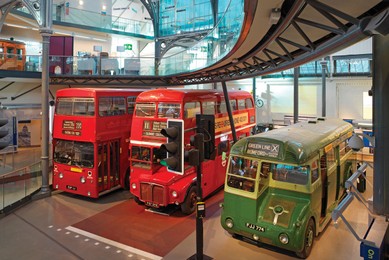 In the Victorian building, built in glass and iron, which hosts the London Transport Museum, and which was designed in 1871 by William Rogers, a flower market has taken place since 1980. In the museum, the attempt has been made to preserve the heritage of the city in the transport sector and explain the evolution and the history since the days, back in 1933, when the whole system of Greater London and the adjoining counties were unified, and which was to become, years later, one of the most extended cities of the world.
In the Victorian building, built in glass and iron, which hosts the London Transport Museum, and which was designed in 1871 by William Rogers, a flower market has taken place since 1980. In the museum, the attempt has been made to preserve the heritage of the city in the transport sector and explain the evolution and the history since the days, back in 1933, when the whole system of Greater London and the adjoining counties were unified, and which was to become, years later, one of the most extended cities of the world. Here sits a collection of old buses, which have been sent into retirement and replaced by faster, more modern ones, along with a number of trams, and some metropolitan trains, which all give the idea of the changes which have been applied to the inside of the carriages. There are also some lovely steam engines in hues of red and yellow, all slick and shiny. After the renovation of 2005, the museum became one of the main tourist attractions of Covent Garden, which also attracts many children. The shop at the entrance sells many publications on the subject.
THEATRE ROYAL
DRURY LANEUNDERGROUND: COVENT GARDEN
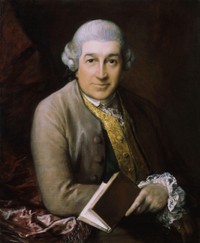 The first theatre of the capital was built in 1663 on Catherine Street and destroyed by a fire. The second one, designed by Wren, was left standing for one hundred and twenty years and hosted the great David Garrick from 1747 to 1775. In 1794 a third one was built, even larger still. The current one can hold over two thousand people. It is the property of the composer Lloyd Webber and, for the most part, musicals are shown.
The first theatre of the capital was built in 1663 on Catherine Street and destroyed by a fire. The second one, designed by Wren, was left standing for one hundred and twenty years and hosted the great David Garrick from 1747 to 1775. In 1794 a third one was built, even larger still. The current one can hold over two thousand people. It is the property of the composer Lloyd Webber and, for the most part, musicals are shown.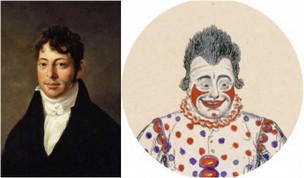 It is said that the theatre is haunted by the ghost of the clown Grimaldi and by that of a man with a grey knight's jacket and a cocked hat on his head, who appears at the opening evening and brings good luck to the show. He has supposedly been sighted by the actors, as well as by firemen and cleaning staff, who apparently stopped to have a chat with him.
It is said that the theatre is haunted by the ghost of the clown Grimaldi and by that of a man with a grey knight's jacket and a cocked hat on his head, who appears at the opening evening and brings good luck to the show. He has supposedly been sighted by the actors, as well as by firemen and cleaning staff, who apparently stopped to have a chat with him. 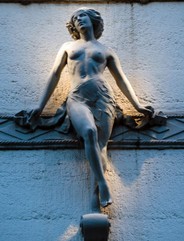 On the wall of the nearby Fortune Theatre, in Russell Street, there is a female Art Déco nude, which leans against a frieze with some diamond-shaped illustrations. The woman is gazing downwards whilst rubbing her right foot against her left leg. The theatre was designed by the architect Ernest Schaufelberg and opened in 1924. Dryden Street, much like Drury Lane, is a street of theatres, and is somewhat London's Broadway. On the facade of one of these, there is a bas-relief which depicts a sleeping princess, and symbolizes a muse.
On the wall of the nearby Fortune Theatre, in Russell Street, there is a female Art Déco nude, which leans against a frieze with some diamond-shaped illustrations. The woman is gazing downwards whilst rubbing her right foot against her left leg. The theatre was designed by the architect Ernest Schaufelberg and opened in 1924. Dryden Street, much like Drury Lane, is a street of theatres, and is somewhat London's Broadway. On the facade of one of these, there is a bas-relief which depicts a sleeping princess, and symbolizes a muse.ROYAL OPERA HOUSE
BOW STREET
UNDERGROUND: COVENT GARDEN
The Royal Opera House, which hosts the opera and ballet, is part of the history of Covent Garden, much like the theatre. The building dates back to 1858, but most of it, starting with the inside area, was rebuilt between 1997 and 1999. The facade has an elegant porch with six gigantic Corinthian pillars, and a frieze representing Tragedy and Comedy. In the two lateral niches, stand the statues of Melpomene and Talia, the muses who respectively presided over tragedy and comedy, which were carried out by C. Rossi, well-known as a modeller at the Coade stone factory.
In front of the facade of Bow Street, next to the line of red telephones, there is a statue of a young dancer sitting on a stool, the work of Enzo Plazzotta, an Italian sculptor who had always lived in London, and whose bronze works are scattered all over the city. On the Waterside Terrace of Barbican Centre, one can observe the Camargue Horses, 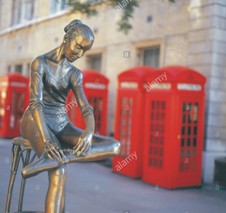 in Belgrave Square we find his Homage to Leonardo, and in Westminster, at the corner of 47, Millbank, stands the statue known as the Jeté, portraying the acrobatic leap of a ballet dancer.
in Belgrave Square we find his Homage to Leonardo, and in Westminster, at the corner of 47, Millbank, stands the statue known as the Jeté, portraying the acrobatic leap of a ballet dancer.
 in Belgrave Square we find his Homage to Leonardo, and in Westminster, at the corner of 47, Millbank, stands the statue known as the Jeté, portraying the acrobatic leap of a ballet dancer.
in Belgrave Square we find his Homage to Leonardo, and in Westminster, at the corner of 47, Millbank, stands the statue known as the Jeté, portraying the acrobatic leap of a ballet dancer.Starting in 1735, Friedrich Händel, who was the theatre director, presented some of his works here, such as The Faithfull Shepherd, Ariodante, Alcina, and Atalanta.
In 1743 the Messiah was performed in front of the royal family. Starting in the Nineteenth Century, the clown Joseph Grimaldi would perform there with great success. His father Giuseppe had died when he was only just nine and had left him and his mother full of debts to pay back. On the stage, he would recite the role of Harlequin, but with visual tricks and innovative clown antics. 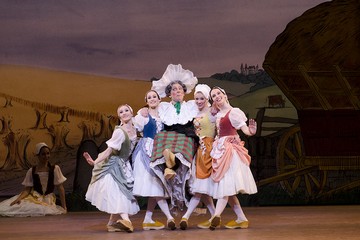 He would mock the spectators and amuse them by including them in his pranks and humorous songs. He introduced the pantomime dame, the Christmas show aimed mainly at children, where the male role is carried out by a woman, and that of a funny old woman, the dame, is performed by a man. On the subject of Grimaldi: in the church of All Saints in Haggerston, Hackney, on the first Sunday of each February, every year hundreds of clowns from all over the world meet up in his memory. At the end of the service, there is a show for children.
He would mock the spectators and amuse them by including them in his pranks and humorous songs. He introduced the pantomime dame, the Christmas show aimed mainly at children, where the male role is carried out by a woman, and that of a funny old woman, the dame, is performed by a man. On the subject of Grimaldi: in the church of All Saints in Haggerston, Hackney, on the first Sunday of each February, every year hundreds of clowns from all over the world meet up in his memory. At the end of the service, there is a show for children.
 He would mock the spectators and amuse them by including them in his pranks and humorous songs. He introduced the pantomime dame, the Christmas show aimed mainly at children, where the male role is carried out by a woman, and that of a funny old woman, the dame, is performed by a man. On the subject of Grimaldi: in the church of All Saints in Haggerston, Hackney, on the first Sunday of each February, every year hundreds of clowns from all over the world meet up in his memory. At the end of the service, there is a show for children.
He would mock the spectators and amuse them by including them in his pranks and humorous songs. He introduced the pantomime dame, the Christmas show aimed mainly at children, where the male role is carried out by a woman, and that of a funny old woman, the dame, is performed by a man. On the subject of Grimaldi: in the church of All Saints in Haggerston, Hackney, on the first Sunday of each February, every year hundreds of clowns from all over the world meet up in his memory. At the end of the service, there is a show for children.Floral Hall - If one is not interested in theatre shows, alternatively one may visit Floral Hall for a drink. The name of the gigantic glass structure next to the theatre is in truth Paul Hamlyn Hall, however seeing as it was once part of the flower market, the old name has stuck. It now serves as an entrance hall for the public and many restaurants stand just opposite. One may take the great glass elevator which passes through the glass-panelled veranda and reach the bar at the top, where one can observe the London's silhouette against the sky. At lunch time, there are free concerts with music by Mozart, Debussy, Wagner, and others. They start at 1 p.m., and are usually held in the exceedingly beautiful baroque-style Crush Room, or in the Lindbury Studio. 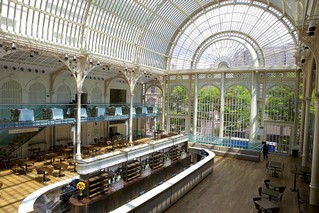 It is necessary to head to the box office half an hour beforehand to withdraw tickets. Some are also available on Internet and can be booked in advance. On the subject of free events, another is the yearly Ignite Festival, which includes jazz music, artistic events, dancing and film shows, which does not only take place here. The festival also gives one the opportunity to visit the theatre and terrace. For anyone into the genre, on Friday afternoons, in the brightly-lit Paul Hamlin Hall, one can dance waltz, tango, and cha-cha-chà. Bear in mind that one may also buy the tickets for the Royal Opera House at a reduced price: in this case one must ask for a restricted view seat, where one does not get quite such a complete view of the stage.
It is necessary to head to the box office half an hour beforehand to withdraw tickets. Some are also available on Internet and can be booked in advance. On the subject of free events, another is the yearly Ignite Festival, which includes jazz music, artistic events, dancing and film shows, which does not only take place here. The festival also gives one the opportunity to visit the theatre and terrace. For anyone into the genre, on Friday afternoons, in the brightly-lit Paul Hamlin Hall, one can dance waltz, tango, and cha-cha-chà. Bear in mind that one may also buy the tickets for the Royal Opera House at a reduced price: in this case one must ask for a restricted view seat, where one does not get quite such a complete view of the stage.
 It is necessary to head to the box office half an hour beforehand to withdraw tickets. Some are also available on Internet and can be booked in advance. On the subject of free events, another is the yearly Ignite Festival, which includes jazz music, artistic events, dancing and film shows, which does not only take place here. The festival also gives one the opportunity to visit the theatre and terrace. For anyone into the genre, on Friday afternoons, in the brightly-lit Paul Hamlin Hall, one can dance waltz, tango, and cha-cha-chà. Bear in mind that one may also buy the tickets for the Royal Opera House at a reduced price: in this case one must ask for a restricted view seat, where one does not get quite such a complete view of the stage.
It is necessary to head to the box office half an hour beforehand to withdraw tickets. Some are also available on Internet and can be booked in advance. On the subject of free events, another is the yearly Ignite Festival, which includes jazz music, artistic events, dancing and film shows, which does not only take place here. The festival also gives one the opportunity to visit the theatre and terrace. For anyone into the genre, on Friday afternoons, in the brightly-lit Paul Hamlin Hall, one can dance waltz, tango, and cha-cha-chà. Bear in mind that one may also buy the tickets for the Royal Opera House at a reduced price: in this case one must ask for a restricted view seat, where one does not get quite such a complete view of the stage.LONG ACRE
UNDERGROUND: COVENT GARDEN,
LEICESTER SQUARE
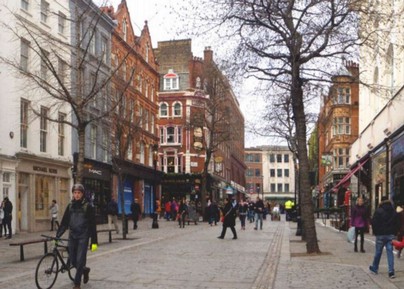 The name refers to the unit of measurement of the acre, which is equivalent to four thousand forty-six square metres. This is a reminder of the fact that there were once fields here. Oliver Cromwell lived here from 1637 to 1643. At the corner of Long Acre with Mercer Street, just in front of Stanfords bookshop, there is a large vertical sign, with the words "Armstrong Siddeley" and "Connaught Coachworks". In post-war England, the Siddeley Sapphires were extremely elegant six-cylinder automobiles, manufactured in Coventry. The name Armstrong was added after the company merged with the American Armstrong company. Beneath the sign, there is a hall for exhibitions and Siddeley car sales.
The name refers to the unit of measurement of the acre, which is equivalent to four thousand forty-six square metres. This is a reminder of the fact that there were once fields here. Oliver Cromwell lived here from 1637 to 1643. At the corner of Long Acre with Mercer Street, just in front of Stanfords bookshop, there is a large vertical sign, with the words "Armstrong Siddeley" and "Connaught Coachworks". In post-war England, the Siddeley Sapphires were extremely elegant six-cylinder automobiles, manufactured in Coventry. The name Armstrong was added after the company merged with the American Armstrong company. Beneath the sign, there is a hall for exhibitions and Siddeley car sales.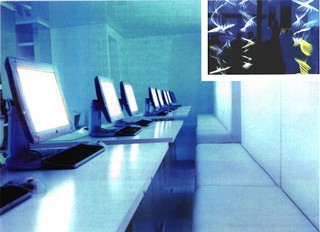 Nutopia - In the parallel street, Shelton Street, there is a cyber hall like none other! Visitors are submerged in a relaxing aquamarine light, which is present in all the rooms, and it gives one the feeling of being inside a spacecraft of some sort, floating through the endless abyss. The environment is completed by a series of luminous abstract sculptures. Also, as Nutopia is also a place for art, there are exhibitions by digital artists, who present artwork created on computers. The computers glow in the dim light of the laboratories, whilst thirsty internauts consume organic fruit juice. The aim is to create a worldwide net with a database for computer artists. At number 16 of the nearby Neal's Yard, very near Seven Dials, there is a New Age shop selling soothing music, stress-busting crystals, Ayurveda products, joss sticks, and perfumes which have been conceived with the aim of bringing about peace of mind...
Nutopia - In the parallel street, Shelton Street, there is a cyber hall like none other! Visitors are submerged in a relaxing aquamarine light, which is present in all the rooms, and it gives one the feeling of being inside a spacecraft of some sort, floating through the endless abyss. The environment is completed by a series of luminous abstract sculptures. Also, as Nutopia is also a place for art, there are exhibitions by digital artists, who present artwork created on computers. The computers glow in the dim light of the laboratories, whilst thirsty internauts consume organic fruit juice. The aim is to create a worldwide net with a database for computer artists. At number 16 of the nearby Neal's Yard, very near Seven Dials, there is a New Age shop selling soothing music, stress-busting crystals, Ayurveda products, joss sticks, and perfumes which have been conceived with the aim of bringing about peace of mind...STANFORDS, THE BIGGEST TRAVEL BOOKSHOP IN THE WORLD
7 MERCER WALK
UNDERGROUND: COVENT GARDEN, LEICESTER SQUARE
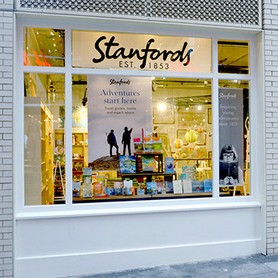 Behind the looming Edwardian facade of this building, there is a huge bookshop with maps and books on the subject of globetrotting. Stanfords opened way back in 1901, and since then has continued to develop, reaching an incredibly vast choice of maps, books, travel accessories, globe maps, and planispheres. On the ground floor, one can find travel literature, stationary, children's books, and toys. At the back of the shop is the Sacred Café, selling fair-trade tea and coffee, along with delicious Muffins. On the lower floor, one can find guides and maps of London, historical maps, mountaineering manuals, books about cycling, food, and wine, guides for any destination one can think of, as well as clothing for activities out in the open. Also, on the wall is the biggest map of the world by National Geographic, whereas the ceiling bears a map of our solar system.
Behind the looming Edwardian facade of this building, there is a huge bookshop with maps and books on the subject of globetrotting. Stanfords opened way back in 1901, and since then has continued to develop, reaching an incredibly vast choice of maps, books, travel accessories, globe maps, and planispheres. On the ground floor, one can find travel literature, stationary, children's books, and toys. At the back of the shop is the Sacred Café, selling fair-trade tea and coffee, along with delicious Muffins. On the lower floor, one can find guides and maps of London, historical maps, mountaineering manuals, books about cycling, food, and wine, guides for any destination one can think of, as well as clothing for activities out in the open. Also, on the wall is the biggest map of the world by National Geographic, whereas the ceiling bears a map of our solar system. Instead, where Endell Street finishes, at number 32, we find a famous sports' centre with a huge open swimming pool, which goes by the name Oasis.
GARRICK STREET
UNDERGROUND: LEICESTER SQUARE
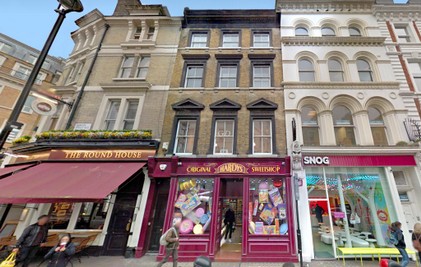 This street was built in 1860 through Long Acre, when administrators decided to clean out the slums in the area. The most famous building is located at numbers 13 and 15, and hosts the Garrick Club, a rather exclusive club counting 1500 members, which does not admit women within its ranks. The only exception that has ever been made was for a conference given by two female travellers who had climbed the Kilimanjaro. Charles Dickens, J.M. Barrie, Dante Gabriel Rossetti, Laurence Olivier, John Gielgud, and Noël Coward were once members, and presently Stephen Fry is a member. The club hosts an excellent theatre bookshop and a significant collection of paintings and sculptures connected to the theatre.
This street was built in 1860 through Long Acre, when administrators decided to clean out the slums in the area. The most famous building is located at numbers 13 and 15, and hosts the Garrick Club, a rather exclusive club counting 1500 members, which does not admit women within its ranks. The only exception that has ever been made was for a conference given by two female travellers who had climbed the Kilimanjaro. Charles Dickens, J.M. Barrie, Dante Gabriel Rossetti, Laurence Olivier, John Gielgud, and Noël Coward were once members, and presently Stephen Fry is a member. The club hosts an excellent theatre bookshop and a significant collection of paintings and sculptures connected to the theatre.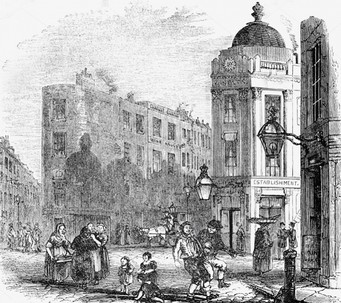 The unusual name refers to the column with sundials which used to stand at the junction of seven roads, in an almost circular spot, which was removed in 1773. The consistent number of roads, according to the original plan, was supposed to provide the greatest possible number of buildings along their sides. However, unfortunately the area deteriorated and became a conglomerate of hovels and shacks, with a high crime rate.
The unusual name refers to the column with sundials which used to stand at the junction of seven roads, in an almost circular spot, which was removed in 1773. The consistent number of roads, according to the original plan, was supposed to provide the greatest possible number of buildings along their sides. However, unfortunately the area deteriorated and became a conglomerate of hovels and shacks, with a high crime rate. Dickens described it effectively in Bleak House and in Sketches by Boz: "The stranger who finds himself in the Dials for the first time...at the entrance of Seven obscure passages, uncertain which to take, will see enough around him to keep his curiosity awake for no inconsiderable time..." In 1929, Agatha Christie chose this place as the setting of her detective story The Seven Dials Mystery, wherein the neighbourhood appears as a synonym of urban misery. The horrors of this criminal area are also represented in the Gin Lane print, by Hogarth.
On Saturday morning, it is a pleasant place to come to do some shopping, as it is rich with boutiques and independent shops, filled with bizarre items which make for good presents, which are both original and fun. Also, one can come here for the theatres, bars, and restaurants. Inside the Dial, the history of the neighbourhood is explained.
SEVEN DIALS
UNDERGROUND: COVENT GARDEN
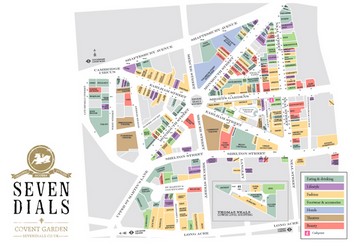 Inside the Seven Dials Warehouse, for those who appreciate artisan products, the Tibet Dreams represents a lovely alternative to mass-produced items, with items of Tibetan craftsmanship, for example hand-made teacups made by potters, or unique specimens of a small piece of furniture, that can all give one far greater pleasure than items that are produced as exact copies of each other. At number 41 of the same street, stands the Donmar Warehouse, which has been transformed into a theatre, capable of holding 250 people. The group, created by Sam Mendes, has earned the fame of excellence. Alongside the classics, many new dramas are enacted by emerging playwrights.
Inside the Seven Dials Warehouse, for those who appreciate artisan products, the Tibet Dreams represents a lovely alternative to mass-produced items, with items of Tibetan craftsmanship, for example hand-made teacups made by potters, or unique specimens of a small piece of furniture, that can all give one far greater pleasure than items that are produced as exact copies of each other. At number 41 of the same street, stands the Donmar Warehouse, which has been transformed into a theatre, capable of holding 250 people. The group, created by Sam Mendes, has earned the fame of excellence. Alongside the classics, many new dramas are enacted by emerging playwrights. AMID DREAMS OF TIBET AND BRASILIAN CINNAMON
50, EARLHAM STREET
UNDERGROUND: COVENT GARDEN
In the same street, at number 33, there is a quaint Brazilian restaurant, The Canela, where one can taste the typical dish, Feijoada, a stew of meat and beans served with rice. Also on the menu are cheese bread, salted cod which goes by the name of bacalhau, and the Pasteis de nata, a cake with a custard filling. One can drink the famous caipirinha, made with Cachaça, as well as mohito or the juice of the açai fruit. The aromatic cinnamon coffee is also delightful.
NEAL STREET
UNDERGROUND: COVENT GARDEN
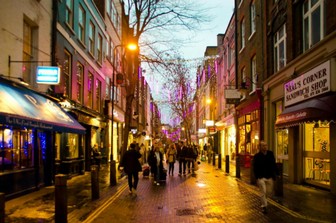 It is a famous street in Covent Garden, where every day thousands of people pass by. Very few, however, know the origin of its name. It is named in memory of Thomas Neale, who in 1693 prepared the plan for the round square of Seven Dials, including the central column. He was a member of parliament for over thirty years, he occupied the post of Master of the Mint, and as well as Seven Dials, he also planned the development of Shadwell and Turnbridge Wells. Amongst some of the oddities which he was involved in, is the design of a pair of cheat-proof dice.
It is a famous street in Covent Garden, where every day thousands of people pass by. Very few, however, know the origin of its name. It is named in memory of Thomas Neale, who in 1693 prepared the plan for the round square of Seven Dials, including the central column. He was a member of parliament for over thirty years, he occupied the post of Master of the Mint, and as well as Seven Dials, he also planned the development of Shadwell and Turnbridge Wells. Amongst some of the oddities which he was involved in, is the design of a pair of cheat-proof dice. This street is also where the shop Neal's Yard is located, where one can buy traditionally-made organic cheese. This shop is the London equivalent of the Slow Food concept of Italian brands, such as Eataly, a way of defending products prepared in a natural and artisanal way. Neal's Yard was the precursor of the wholemeal trend, starting with bread.
At number 14, Neal's Yard, on the first floor, we find the Neal's Yard World Food Café. The menu includes edible roots, a chickpea masala served with brown rice, and a selection of turkish hors d'oeuvres, meze, tabulé, and pita bread.PHOTOGRAPHER'S GALLERY
5-8 GREAT NEWPORT STREET
UNDERGROUND: LEICESTER SQUARE
The two storey building, with black tiles, hosts the largest gallery in London covering photography. Historical archives are kept here, but excellent exhibitions are also held here, dedicated to famous artists or emerging talents, who, dissatisfied with the traditional function of photography as a reproduction of the outside world, move on to explore its various dimensions, on a journey seeking new and undiscovered potential.
After having explored each and every aspect of photography, one can enjoy a pleasant cup of coffee along with a slice of homemade cake or a freshly made sandwich in an extremely modern bar, its walls understandably covered with many beautiful photographs.ST MARTIN'S LANE
UNDERGROUND: LEICESTER SQUARE
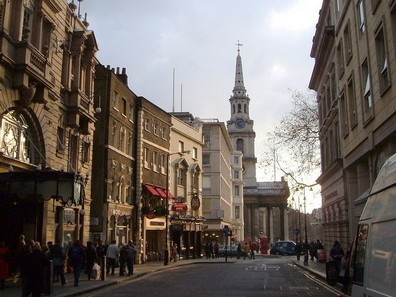 Between 1753 and 1813, at number 60-61 of this street, which today is known mainly for its theatres, there is a laboratory where Thomas Chippendale and his son used to design and build their rococo furniture. This was the headquarters of the Academy founded by Hogarth, which included a group of artists who would gather at Slaughter's Coffee House. It was they who introduced the rococo style into the country's furniture sector, which Thomas Chippendale, a great ebony carpenter and furniture designer, then moved on to fulfil.
Between 1753 and 1813, at number 60-61 of this street, which today is known mainly for its theatres, there is a laboratory where Thomas Chippendale and his son used to design and build their rococo furniture. This was the headquarters of the Academy founded by Hogarth, which included a group of artists who would gather at Slaughter's Coffee House. It was they who introduced the rococo style into the country's furniture sector, which Thomas Chippendale, a great ebony carpenter and furniture designer, then moved on to fulfil.There are as many as three theatres overlooking the street. The Noël Coward, before bearing the name of one of the country's best-known playwrights, used to be called Albery, in honour of its original director. The outside has been built in a classical style, whereas the inside area is delightfully rococo. Together with Shakespeare, also Pinter and Beckett are represented. The Coliseum, with its great tower, which includes a balcony on the facade and a rotating globe at the top, is the biggest and most noticeable of all. It was opened in 1904, when the nearby Duke of York's had already been active for twelve years. It has often hosted musical comedies, such as the Rocky Horror Picture Show in 1995. In this theatre, Giacomo Puccini assisted the performance of Madame Butterfly by David Belasco, the American playwright born in San Francisco during the years of the Gold Rush, of which he later told the story. From Belasco, Puccini also took the content of a second comedy, La fanciulla del West (The Girl of the West).
The Thames embankment was a milestone in health and safety measures laid forth for the city's benefit, as well as a great feat of Victorian engineering.
It was decided that it be built at the end of summer, 1858, when the unbearable stench coming from the Houses of Parliament had underlined the need for a sewage system. In truth, the proposal to embank the Thames at the level of central London dated back to 1660, and had been carried out by the architect Wren. The currently operative works were designed by Bazalgette in 1862, and carried out in three phases: firstly the Victoria Embankment was built at the northern end, then the Albert Embankment to the south, and lastly the Chelsea Embankment in 1874. This work subtracted a vast area of marshy land from the river, and part of the sewage system of the western area of the city was incorporated into it.
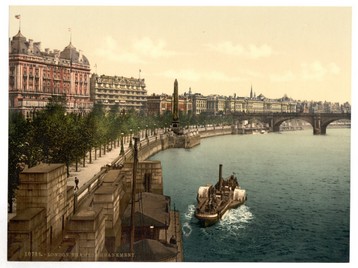 A walk along the banks of the Thames - The walk along the river starting from the Westminster bridge all the way to the Blackfriars bridge is extremely pleasant. One can stop to admire the Banqueting House or make a deviation in order to enter the Victoria Embankment Gardens to admire the statue and fountain. After passing the Hungerford bridge, one reaches Cleopatra's Needle. As one draws nearer to Waterloo Bridge, one can observe the complex of the South Bank on the opposite side of the river, with the Royal Festival Hall and the National Theatre. Further ahead, near Blackfriars Bridge, built in 1869 following the design by James Cubitt, the jetties and cranes of the old docks can be seen.
A walk along the banks of the Thames - The walk along the river starting from the Westminster bridge all the way to the Blackfriars bridge is extremely pleasant. One can stop to admire the Banqueting House or make a deviation in order to enter the Victoria Embankment Gardens to admire the statue and fountain. After passing the Hungerford bridge, one reaches Cleopatra's Needle. As one draws nearer to Waterloo Bridge, one can observe the complex of the South Bank on the opposite side of the river, with the Royal Festival Hall and the National Theatre. Further ahead, near Blackfriars Bridge, built in 1869 following the design by James Cubitt, the jetties and cranes of the old docks can be seen. After crossing the bridge to return to Westminster on the other side of the river, one encounters a huge portcullis with an engraving which says that in 1935 this section of the Thames was called King's Reach, in memory of the Silver Jubilee of George V. A short way ahead, a bronze plaque commemorates the men who lost their life on submarines during the First and Second World Wars. The bas-relief depicts a crew inside a submarine, about to be dragged downwards by nets towards their destruction, pulled by sinister figures. On the lateral panels, the names of the ships lost during the world conflicts are listed. On the wall next to Waterloo Bridge, which was the first cement bridge, one can admire the vast facade of Somerset House. Behind this palace, there is another small garden area with a bronze, life-size statue of the engineer Brunel, created by Carlo Marochetti. The empty pedestal once supported the statue of a little girl holding a jug of water. The monument was erected in memory of Lady Somerset, who preached the virtues of restraint. Unfortunately the statue was stolen.
VICTORIA TOWER GARDENS
ABINGDON STREET
UNDEGROUND: WESTMINSTER
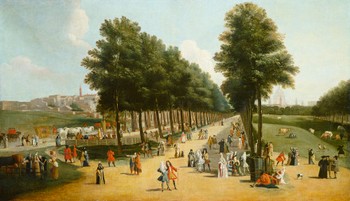 This peaceful area along the banks of the Thames, rich with fields and trees, just south of the Houses of Parliament, is shaped like a long overturned triangle, its tip pointing towards the Lambeth bridge. It is enjoyable to sit on the bank wall and allow one's gaze to stray over the passing boats, the towers of the Lambeth palace, the park, and the docks just opposite.
This peaceful area along the banks of the Thames, rich with fields and trees, just south of the Houses of Parliament, is shaped like a long overturned triangle, its tip pointing towards the Lambeth bridge. It is enjoyable to sit on the bank wall and allow one's gaze to stray over the passing boats, the towers of the Lambeth palace, the park, and the docks just opposite.The gardens, which get their name from the Victoria Tower, once part of the Westminster Palace, were created in 1870, when the platform on which they lie was built. Before this, they were part of the Thames Embankment created by Bazalgette, and were smaller.
They were expanded towards the end of the century via the purchase of a series of docks which were then transformed. One of these was the Dorset, which belonged to Charles Taverner Miller and his son George. Theirs was the ownership of the patent for the manufacturing of candles, prepared through the refinement of spermaceti, the oily substance found in certain cavities of the sperm whale, which after the death of the cetacean, solidifies into a white mass. To give an idea of the personality of the industrialist, a brief anecdote: in 1831, a nineteen-year-old lad who had stolen his silk handkerchief was processed at the Old Bailey and condemned to deportation for fourteen years, to Miller’s great satisfaction.
The bench camels – Some of the benches of Victoria Embankment, decorated with wrought iron, have one particularly unique quality: at the two extremities, in the place of legs, they have two sitting camels, loaded with packs, and each bearing a ribbon around their necks, hanging like a pendant. It would seem that they were created in memory of the troops known as the Imperial Camel Corps, formed in 1916, derived from the troops who fought at Gallipoli.
THE STATUE OF EMMELINE PANKHURST
VICTORIA TOWER GARDENS
UNDERGROUND: WESTMINSTER
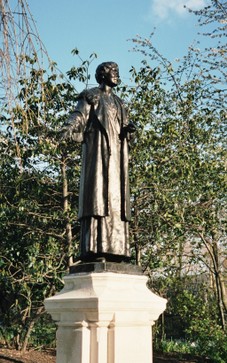 The female statue built in bronze which stands in front of Millbank in Edwardian clothing portrays the figure of Mrs Pankhurst, the leader of the suffragist movement. It was carried out in 1930 by A.G. Walker, and the medallion of a little girl sculpted at her feet represents her daughter Christabel, who did not hesitate to be jailed alongside her, in order to fight not only for women’s right to vote, but also for their right to work. Christabel had been a brilliant student of law, but being a woman, she could not enter the profession. On the left, there is also the symbol of the Prisoner’s Badge, which had been created especially for them. The WSPU, the acronym which stands for Women Social & Political Union, which can be seen to the left, represents the bars of a prison cell, and was carried by women who had been in jail “for the cause”.
The female statue built in bronze which stands in front of Millbank in Edwardian clothing portrays the figure of Mrs Pankhurst, the leader of the suffragist movement. It was carried out in 1930 by A.G. Walker, and the medallion of a little girl sculpted at her feet represents her daughter Christabel, who did not hesitate to be jailed alongside her, in order to fight not only for women’s right to vote, but also for their right to work. Christabel had been a brilliant student of law, but being a woman, she could not enter the profession. On the left, there is also the symbol of the Prisoner’s Badge, which had been created especially for them. The WSPU, the acronym which stands for Women Social & Political Union, which can be seen to the left, represents the bars of a prison cell, and was carried by women who had been in jail “for the cause”.Her followers would chain themselves to gates, and when they were jailed, they would go on hunger strikes, and were then force fed. They would sometimes go a little over the top, by vandalizing works of art in order to attract attention and obtain publicity for themselves.
THE CITIZENS OF CALAIS
VICTORIA TOWER GARDENS
UNDERGROUND: WESTMINSTER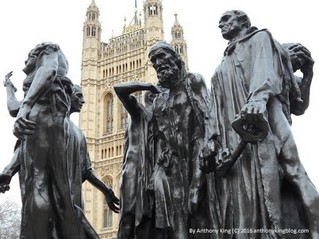 The group of statues in the Victoria Garden Towers is a copy of the one found in Rodin, in Calais. The copy was purchased by the British government in 1911. The statues have slip knots around their necks, and each has a huge key in one hand. When Calais had fallen to the English, after the Battle of Crecy, Edward III wished to hang the male citizens in order to punish them for their long resistance. However queen Filippa of Hainault, originally from Flanders, forced him to desist from his intent and saved their lives. The sculpted group which depicts them hunched over, skinny, and with their gaze fixed on the ground yet not defeated, is quite moving. They are still ready to sacrifice themselves for their city and refuse to turn themselves in to the King of England.
The group of statues in the Victoria Garden Towers is a copy of the one found in Rodin, in Calais. The copy was purchased by the British government in 1911. The statues have slip knots around their necks, and each has a huge key in one hand. When Calais had fallen to the English, after the Battle of Crecy, Edward III wished to hang the male citizens in order to punish them for their long resistance. However queen Filippa of Hainault, originally from Flanders, forced him to desist from his intent and saved their lives. The sculpted group which depicts them hunched over, skinny, and with their gaze fixed on the ground yet not defeated, is quite moving. They are still ready to sacrifice themselves for their city and refuse to turn themselves in to the King of England. THE BUXTON FOUNTAIN
VICTORIA TOWER GARDEN
UNDERGROUND: WESTMINSTER
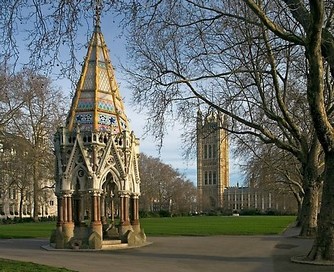 The fountain was built in 1865, the year slavery was abolished in America. It commemorates the emancipation of slaves in the British Empire, which had taken place around thirty years earlier, in 1834. The fountain was erected in memory of Fowell Buxton, William Wilbeforce, and the members of Parliament who had contributed to the abolishment of slavery. It has a very elaborate Victorian structure, with statues of kings, mosaics, and coloured tiles.
The fountain was built in 1865, the year slavery was abolished in America. It commemorates the emancipation of slaves in the British Empire, which had taken place around thirty years earlier, in 1834. The fountain was erected in memory of Fowell Buxton, William Wilbeforce, and the members of Parliament who had contributed to the abolishment of slavery. It has a very elaborate Victorian structure, with statues of kings, mosaics, and coloured tiles.NEW SCOTLAND YARD
8-10 BROADWAY
UNDERGROUND: ST JAMES'S PARK
The Metropolitan Police Service, founded in 1829 by Robert Peel, answers directly to the Ministry of Internal Affairs. Its headquarters is an austere three-storey building built in 1890 following Norman Shaw's design. The facade is in granite on the ground floor and built with bricks at the higher floors. The circular turrets which decorate the corners make it seem somewhat like a medieval castle. Since 1967 the building which is New Scotland Yard has stood on the Embankment, while the old building offers lodging to the Members of Parliament.
QUEEN MARY'S STEPS
WHITEHALL
UNDERGROUND: EMBANKMENT
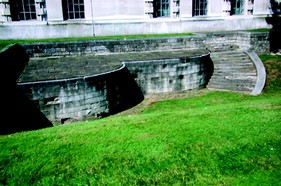 The building of the Ministry of Defence, designed in 1898 by William Young, stands on the edge of the Richmond Terrace, which was built by Wren for Queen Mary II.
The building of the Ministry of Defence, designed in 1898 by William Young, stands on the edge of the Richmond Terrace, which was built by Wren for Queen Mary II. 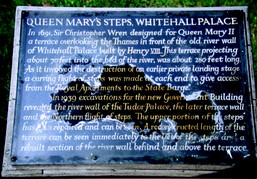 Today, the two flights of steps in front of the palace, which were once on the water's edge, give us an idea of how much space was subtracted from the river in order to build the Embankment.
Today, the two flights of steps in front of the palace, which were once on the water's edge, give us an idea of how much space was subtracted from the river in order to build the Embankment. THE PANELS OF NORTHUMBERLAND HOUSE
8, NORTHUMBERLAND AVENUE
UNDERGROUND: CHARING CROSS
Northumberland House used to stand where Northumberland Avenue, built in 1847, cuts across Charing Cross towards the river bank. In 1874 it had to be demolished to make room for Northumberland Avenue. Elizabeth Smithson, daughter of the duke of Somerset and wife of the duke of Northumberland, had assigned Robert Adam to build a living room decorated with glass. As well as red, green and sparkling glass panes, framed with gilded metal, and many mirrors, Adam placed paintings above the doors and in the oval windows, carried out by Cipriani.
It is perhaps the most sophisticated inside area ever created by Adam. At the time of the Great Exhibition, the palace was opened to the public, following the request of Prince Albert. Adam’s style, however, was not greatly admired at the time and considered rather intricate and discordant. In 1873, the duke had adhered, although reluctantly, to the administrator’s request to sell the house, in order to build in its place a new access to the Thames embankment. The hall panels were removed and sold to an antique dealer, who would rent them as decorations for novice ballet dancers. In 1955, they were purchased by the Victoria & Albert Museum, where they have been reconstructed as if forming a room, and one can now admire them there.THE OLD LAMPS OF THE VICTORIA EMBANKMENT GARDENS
UNDERGROUND: EMBANKMENT, TEMPLE
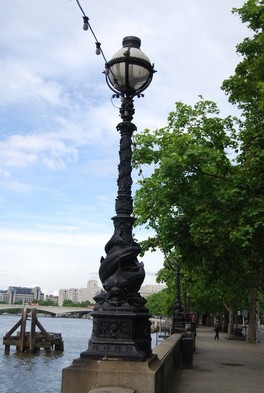 The Victoria Embankment Gardens are a peaceful oasis where one can stay and go for a walk in the heart of the city. Scattered around them are statues, dedicated to characters such as Arthur Sullivan, portrayed in the act of staring into the distance, over the garden and into the distance. He seems to be ignoring the young girl, naked from the waist upwards, leaning against his plinth. The funeral monument was designed in 1903 by William Goscombe John to celebrate the component of the famous duo Gilbert and Sullivan, an author of musical comedies. Amongst the statues, one of them is dedicated to the engineer Bazalgette, as might be expected, who was responsible for the construction of the embankment itself, the impoundment of the Thames which restricted its riverbed. Among the funeral monuments is that of William Tyndale, who in 1520 was one of the first sustainers of the Reform, and this made him a controversial figure. He was ahead of his time in maintaining that God’s word should be available to all in an English version, and not only in Greek, a language understood only by the clergy, which could therefore exert a greater amount of control on followers. However, his work of translation, which started with the New Testament, forced him to leave the country to go to Worms, where he was encouraged by Erasmus and Luther. Later on, he went to Antwerp, where he was arrested for having attempted to translate the Old Testament. In the Vilvorde Castle he was strangled and burnt on the stake. One year after Tyndale had paid for his ideas with his life, the Bible had begun to circulate in English, as he had maintained that it should. The monument shows him with his right hand resting on an open copy of the Holy Bible, which in turn is resting on an ancient printing press. One of the most interesting things to see along the side of the road and along the riverside parapet, is the array of Victorian gas lamps with their metallic reticules of bright green hues. Great dolphins are twisted around some of the posts; others are decorated with roses. This is where Cleopatra’s Needle stands, an Egyptian stele, which, despite its name, has no historical connection with the queen, considering that the hieroglyphics refer to the pharaoh Thutmose III. It was transported to London in 1878. Underneath it, a time capsule is buried, which consists of a trunk containing various artefacts from the Victorian epoch. In 1917 it was slightly damaged by a bomb, and one can still see the signs on its base.
The Victoria Embankment Gardens are a peaceful oasis where one can stay and go for a walk in the heart of the city. Scattered around them are statues, dedicated to characters such as Arthur Sullivan, portrayed in the act of staring into the distance, over the garden and into the distance. He seems to be ignoring the young girl, naked from the waist upwards, leaning against his plinth. The funeral monument was designed in 1903 by William Goscombe John to celebrate the component of the famous duo Gilbert and Sullivan, an author of musical comedies. Amongst the statues, one of them is dedicated to the engineer Bazalgette, as might be expected, who was responsible for the construction of the embankment itself, the impoundment of the Thames which restricted its riverbed. Among the funeral monuments is that of William Tyndale, who in 1520 was one of the first sustainers of the Reform, and this made him a controversial figure. He was ahead of his time in maintaining that God’s word should be available to all in an English version, and not only in Greek, a language understood only by the clergy, which could therefore exert a greater amount of control on followers. However, his work of translation, which started with the New Testament, forced him to leave the country to go to Worms, where he was encouraged by Erasmus and Luther. Later on, he went to Antwerp, where he was arrested for having attempted to translate the Old Testament. In the Vilvorde Castle he was strangled and burnt on the stake. One year after Tyndale had paid for his ideas with his life, the Bible had begun to circulate in English, as he had maintained that it should. The monument shows him with his right hand resting on an open copy of the Holy Bible, which in turn is resting on an ancient printing press. One of the most interesting things to see along the side of the road and along the riverside parapet, is the array of Victorian gas lamps with their metallic reticules of bright green hues. Great dolphins are twisted around some of the posts; others are decorated with roses. This is where Cleopatra’s Needle stands, an Egyptian stele, which, despite its name, has no historical connection with the queen, considering that the hieroglyphics refer to the pharaoh Thutmose III. It was transported to London in 1878. Underneath it, a time capsule is buried, which consists of a trunk containing various artefacts from the Victorian epoch. In 1917 it was slightly damaged by a bomb, and one can still see the signs on its base. WHITEHALL COURT
WHITEHALL COURT
UNDERGROUND: EMBANKMENT
Its towers look like those of a castle of the Loire o Rhine areas, however in actual fact they are in the pure neo-gothic style, and date back to 1884. The palace is made up of two separate buildings, and amongst others include designs by Alfred Waterhouse, known for the Natural History Museum. A part of it is occupied by the Royal Horseguards Hotel, whereas the remaining part hosts a number of private residencies.
From here, one can get a charming view of the Horse Guard Parade. In the garden opposite, which faces the river, there are three bronze statues. Some of the famous residents have included George Bernard Shaw and H.G. Wells. One of the extremities hosts the National Liberal Club, founded by William Gladstone in 1882 and named with a political connotation of progressive character and vaguely bohemian. Also the Intelligence Service was born here.This monument appears in the background of any photos that happen to be taken from the bridge of St James’s Park, often unbeknownst to the photographers themselves, and it enhances the romantic perspective of these scenic compositions.
In 1951 the architects Clyde, Young, and Engel added a marble staircase which leads all the way up to the third floor, without any form of bannister.
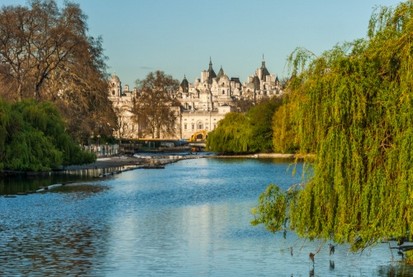 The area of St James extends to the south of Piccadilly, reaching through the Mall and St James’s Park, all the way to Birdcage Walk. It is an area of royal residencies, elegant houses, delightful shops, and trade galleries. Bond Street is the street of reference for women’s shopping, and Jermyn Street likewise but for men’s items. Here one can find shirts tailored to size, handmade ties, leather bags and belts, vintage wine... In St James’s Street there are a number of exclusive eighteenth-century clubs, such as Brook’s, the Carlton, White’s, and Boodle’s.
The area of St James extends to the south of Piccadilly, reaching through the Mall and St James’s Park, all the way to Birdcage Walk. It is an area of royal residencies, elegant houses, delightful shops, and trade galleries. Bond Street is the street of reference for women’s shopping, and Jermyn Street likewise but for men’s items. Here one can find shirts tailored to size, handmade ties, leather bags and belts, vintage wine... In St James’s Street there are a number of exclusive eighteenth-century clubs, such as Brook’s, the Carlton, White’s, and Boodle’s. The neighbourhood is filled with fascinating things, not only inside the shops but also outside, like for example the Tobacco Indians of St James’s Street. These two coloured wooden statues, which have been placed on the pavement in front of the cigar shop James J. Fox and Robert Lewis, represent two native Americans. The inside of the shop is similar to that of a club. There are leather armchairs, lampshades which give off green light, carpets, and other charming features.
There are famous tobacco brands, such as Bolivar and Partagas. Winston Churchill would visit from time to time, and sit on one of the shop’s armchairs to enjoy a Romeo y Julieta or an Aroma de Cuba.
In the area of St James’s Park, there are many galleries, which are especially concentrated in Duke Street. One of the better-known ones is the one located at number 41. It exhibits the works of British, European, and International painters, and provides expert advisors who are well-versed in international art markets. The most famous street in the area is Pall Mall, the name of which derives from the game of pall-mall, which used to be practiced in the Seventeenth Century. The street is famous for its clubs, to the point that Conan Doyle chose it for the imaginary Diogenes Club, inserted into the Sherlock Holmes book, the Greek Interpreter. With his usual irony, the author describes it as a club created for men who, due to shyness and misanthropy, have little love for the company of other men and none at all that of women.
This is a club where one may not talk and one is expelled if one coughs, however one can spend the afternoon on a comfortable armchair with a newspaper, which is what the members appreciate the most. The southern part of the street is property of the Crown. Number 100, between 1824 and 1834, once held the headquarters of the National Gallery. After the Restoration, the Mall was built, which runs alongside the park, and provides an extraordinary approach to Buckingham Palace, reminding one a little of the Champs- Élisées in Paris.
ST JAMES'S PALACE
PALL MALL
UNDERGROUND: GREEN PARK
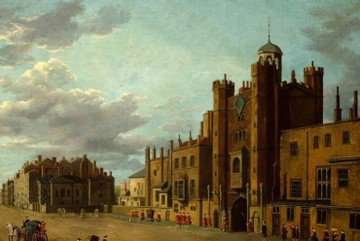 St James’s Palace is located a short way north of St James’s Park and is one of the oldest in London. It was built in 1530, commissioned by Henry VIII, on the grounds of a hospital for lepers, which was dedicated to St James the Less, from whom the palace and the park got their name. It encloses four courtyards, with a facade of red bricks and polygonal towers at the sides of the entrance gate. It was once a royal residence. Queen Mary Tudor died here, Charles I attended his execution here, and Charles II made it his main residence, and had a pitch built for pall-mall, as well as a garden crossed by the waters of a canal, later opened to the public. Cromwell transformed it into a barracks. In spite of the fires that erupted, a number of structures have survived, as well as some decorations by Wren and others. Most of the Palace was restructured during the Nineteenth Century and stopped being a royal residence when Buckingham Palace took its place. William Morris and his collaborators restored the Armoury and Tapestry room. The palace is still operative today, and is part of a complex, which also includes York House, where princes Harry and William live, and Clarence House, where the Queen Mother used to live, and where the Prince of Wales moved after her death. It is possible to enter the yards, where one can admire the building.
St James’s Palace is located a short way north of St James’s Park and is one of the oldest in London. It was built in 1530, commissioned by Henry VIII, on the grounds of a hospital for lepers, which was dedicated to St James the Less, from whom the palace and the park got their name. It encloses four courtyards, with a facade of red bricks and polygonal towers at the sides of the entrance gate. It was once a royal residence. Queen Mary Tudor died here, Charles I attended his execution here, and Charles II made it his main residence, and had a pitch built for pall-mall, as well as a garden crossed by the waters of a canal, later opened to the public. Cromwell transformed it into a barracks. In spite of the fires that erupted, a number of structures have survived, as well as some decorations by Wren and others. Most of the Palace was restructured during the Nineteenth Century and stopped being a royal residence when Buckingham Palace took its place. William Morris and his collaborators restored the Armoury and Tapestry room. The palace is still operative today, and is part of a complex, which also includes York House, where princes Harry and William live, and Clarence House, where the Queen Mother used to live, and where the Prince of Wales moved after her death. It is possible to enter the yards, where one can admire the building.The stamps of the kings – One of the most interesting curiosities of St James’s Palace is the royal family’s stamp collection. It is the most complete in the whole of the United Kingdom and Commonwealth, and includes many rare or unique stamps, such as the Mauritius Two Pence blue, which was paid for by the King with an amount of one thousand five hundred pounds, an important amount of money at the time. Some stamps date back to 1854, the year of the twenty-fifth anniversary of their introduction. Obviously the royal family has made use of expert advisors, collaborators, and curators in order to put together such a huge collection and preserve it with care. After having been preserved for a century in Buckingham Palace, it was brought here, where exhibitions are organized by the Royal Philatelic Society, which has been around since 1869 and is the most ancient in the world. It has the purpose of promoting progress and the knowledge of philately, by means of conferences, research and news.
QUEEN’S CHAPEL
SAVOY HILL, STRAND
UNDERGROUND: COVENT GARDEN
It was designed by Inigo Jones for the French wife of Charles I, Henrietta Maria, and built in 1623, as part of St James’s Palace. It was originally a Catholic church, when the construction of such churches was forbidden in the country. It has an extremely elaborate wooden ceiling. The fire which burnt down the adjoining building and the building on Marlborough Road isolated it from the rest of the palace.
The psalm of the Queen Mother was kept here for a few days whilst awaiting the state funeral and subsequent burial in Westminster Abbey. It has a wooden ceiling with inlaid panels and a gallery for the Royal Enslosure. It seems like the colour of the walls is more or less the same as the original. In the summer months it is occasionally open to the public, on certain Sundays.
KIWIFRUITS
7, ROYAL OPERA ARCADE
UNDERGROUND: CHARING CROSS
This shop is a reminiscence of the Empire, a headquarters for selling products typical of New Zealand: from patriotic T-shirts and exotic fruit marmalades to Manuka honey beauty cream, oil extract from sheep’s wool, or Pohutukawa hand cream, but also items of Maori art, such as Paua jewellery with Pounamu jade pendants. One can find all sorts of things here, including books which delve into the identity of the aborigines.
ST JAMES'S PARK
THE MALL
UNDERGROUND: ST JAMES'S PARK
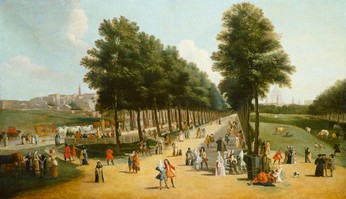 It is the most ancient of all the royal parks in London. In 1532 Henry VIII of England purchased the area, which was marshy because it was continuously flooded by the waters of the Tyburn. The king intended to reclaim it, also because it was close to York Palace, which he wished to transform into a royal palace. In 1603 King James I introduced exotic animals, such as camels, crocodiles, tropical birds, and an elephant. Charles II opened it to the public, after improving it, following the projects of the gardener of the king of France, who he had met during his exile. There is a small lake with two islands, namely Duck Island, so-called because there was once a duck reserve there, and West Island. Along with the ducks, Duck Island has also had an illustrious guest. During the regency of cardinal Mazarin, the French poet Charles de Saint-Evremond had been forced into exile, and had chosen to flee to London. King Charles II did not wish to make an enemy of the French government by offering him hospitality, yet neither did he wish to upset him. As a compromise, he decided to nominate him governor of Duck Island, a title he held until his death. In the lake, there are also some likeable pelicans, some swans, and herons. Behind the weeping willows which stand all along the river, there are small paths which one can take for pleasant walks. From the bridge, built in 1957 following the design of Eric Bedford, one can see Buckingham Palace, surrounded by trees and fountains. On the opposite side, are the towers and the grey rooftops of the government buildings which stand next to Whitehall.
It is the most ancient of all the royal parks in London. In 1532 Henry VIII of England purchased the area, which was marshy because it was continuously flooded by the waters of the Tyburn. The king intended to reclaim it, also because it was close to York Palace, which he wished to transform into a royal palace. In 1603 King James I introduced exotic animals, such as camels, crocodiles, tropical birds, and an elephant. Charles II opened it to the public, after improving it, following the projects of the gardener of the king of France, who he had met during his exile. There is a small lake with two islands, namely Duck Island, so-called because there was once a duck reserve there, and West Island. Along with the ducks, Duck Island has also had an illustrious guest. During the regency of cardinal Mazarin, the French poet Charles de Saint-Evremond had been forced into exile, and had chosen to flee to London. King Charles II did not wish to make an enemy of the French government by offering him hospitality, yet neither did he wish to upset him. As a compromise, he decided to nominate him governor of Duck Island, a title he held until his death. In the lake, there are also some likeable pelicans, some swans, and herons. Behind the weeping willows which stand all along the river, there are small paths which one can take for pleasant walks. From the bridge, built in 1957 following the design of Eric Bedford, one can see Buckingham Palace, surrounded by trees and fountains. On the opposite side, are the towers and the grey rooftops of the government buildings which stand next to Whitehall. If you feel like a tasting some Japanese cuisine, at number 23, St James’s Street, where until just a few years ago there was an elegant restaurant called Che, in honour of Guevara, there is now an equally refined Japanese restaurant, the Sake No Hana. It has good reason for its name, as one can choose from over fifty types of sake, including some very unusual ones.
THE DUNHILL PIPE MUSEUM
50, JERMYN STREET
UNDERGROUND: ST JAMES'S PARK
The small museum of Dunhill is full of rare pieces which are priceless, and can be appreciated both by experts and the general public. It is located in the area of the great museums and a small deviation is sufficient to include it in a round of visits. One then comes to discover that the pipe, used by native Americans during religious ceremonies, was introduced to England in the Fifteenth Century by travellers who had smoked it on the other side of the ocean.
Tobacco also came from America. The true origin of the pipe, however, is lost in the past centuries, due to the fact that almost all populations came to know of it in all its different forms and built with very different materials. It seems that it was in use already before the use of tobacco itself, when opium, oregano, and other herbs were dried out and used to this end. Here in Europe, the use of the chamber pipe developed, unlike Islamic countries where the hookah, or water pipe, is used. In any case, also Portuguese and Spanish sailors, who had learnt the use of the calumet, adopted it, and in doing so transformed it. Many poets and writers, such as Baudelaire, Flaubert, Simenon, Pavese, and amongst the women, George Sand, all smoked a pipe.
At the Dunhill Museum, there are many pipes on show, some in briar root, others in rosewood or foam. There are also old illustrated catalogues, posters, and lighters of the strangest shapes and sizes. One of them is built with a varnished golf ball.
LANCASTER HOUSE
STABLE YARD
UNDERGROUND: GREEN PARK
The building was constructed in 1827 by Benjamin Wyatt for the duke of York, though he died before his construction was finished. The house was then sold to the duke of Sutherland , a supporter of social reform, who turned it into an important cultural centre of activity and initiatives, such as the abolition of slavery. In 1848 Queen Victoria, who at his arrival stated: “I have left my house to come to your palace”, would often come here to hear Chopin play the piano. In 1864 also Garibaldi was the duke’s guest, and people would stop him on the streets to greet him. In 1912 the house was sold to the viscount Leverhulme, who donated it to the nation for the creation of the headquarters of the London Museum. Today it is used for official meetings. The facade of the house, aside from the Corinthian porch at the entrance, is quite simple. Its greatness can be witness on the inside, with a majestic hall which leads to a series of state apartments. The most important of these is known as the Grand Gallery, and hosts a painting by Guercino, brought here by the church of San Grisogono of Trastevere in Rome, and placed on the ceiling.
MALBOROUGH HOUSE
PALL MALL
UNDERGROUND: GREEN PARK
The building was built in 1709 by Wren for the duchess of Malborough, the wife of the general. The noblewoman had asked him to pull up a solid, simple, and comfortable building. She also had Louis Laguerre fresco the walls of the hall rooms and those of the great staircase with scenes of the battle where her husband had defeated the French and stopped them from conquering Vienna. The dome is surrounded by frescos that were painted by Gentileschi for the entrance to the Queen’s House at Greenwich. The nine panels, which mimicked the geometric layout of the marble pavement have been detached from their original place and inserted into the compartments of the ceiling. The central panel portrays the nine muses and the liberal arts. Painting, Music, Geometry, and Sculpture decorate the medallions in the corners; the mutilated rectangles, instead, bear Comedy and Tragedy. In 1817 the building became the royal residence and remained so for almost a century and a half. Nowadays it is used by the government for official receptions.
Behind Marlborough Gate, next to St James’s Palace, there is a pretty monument in the Art Nouveau style dedicated to Queen Alexandra, wife of Edward VII. The sculpture, which overlooks Marlborough Road, was carried out by Alfred Gilbert, the same sculptor who created the statue of Eros in Piccadilly Circus. Originally the monument was situated in the wall of the gardens of Marlborough House, where the Queen lived. The statue, commissioned in 1926, is built in bronze enamelled in black, and has a style which resembles Neo-Gothic. The queen sits behind the allegorical figures of Faith, Hope, and Charity.
ST JAMES’S SQUARE
UNDERGROUND: GREEN PARK, PICCADILLY CIRCUS
North-east of the homonymous palace lies the rectangle of streets bordered by Pall Mall, Haymarket, Piccadilly, and St James’s Street. St James’s Square is at the heart of this rectangle. The land was handed down to Henry Jermyn, duke of St Albans, who wished the square to be surrounded by elegant buildings. He set the good example by building his own house, Jermyn House. It stood on the southern side and was demolished in 1938, in order to make room for Norfolk House. The duchess of Norfolk, a catholic, favoured the continental style and called a painter from Turin, Giovanni Battista Borra, to decorate the music hall. The frescos on the ceiling contained the depictions of Painting, Sculpture, Music, Science, Astronomy, Literature, Geometry, and Architecture, the latter wielding the plan for Norfolk House. Borra also designed golden friezes which adorned the mirrors and the chimney, with musical instruments for their subjects. The house, which had hosted the allied troops and General Eisenhower during the Second World War, was later demolished. Only the music room, all painted in white and golden hues, was saved, and can be admired at the Victoria & Albert Museum. House number 4 in Charles II Street is of great architectural interest. It was built by the duke of Kent, who was greatly interested in architecture. It would seem that also the Italian architect Giacomo Leoni worked on it too, and the result is splendid.
At number 20 of the nearby King Street, today belonging to the Distillers Company, which has also purchased the next-door property, stands the most beautiful house. It was built in 1775 by Robert Adam , who embellished it with two Ionic pillars. On the inside, there is plastering of a refined taste on the hall’s ceiling, whereas the chimney bears a pleasing bas-relief and a frieze representing some dancing female figures and a warlord on his chariot. On the opening day, a musical breakfast and a lively country dance were organized. At number 26, King Street, we find the Golden Lion pub: its licence dates all the way back to 1732, and it has preserved an elegant vintage interior design.
LONDON LIBRARY
14 ST JAMES’S SQUARE
UNDERGROUND: PICCADILLY, GREEN PARK
The London Library was founded in 1841 by Thomas Carlyle. The writer was not happy with the content of the British Library, directed by Anthony Panizzi. He defined it as being full of people who sniffle and spit, whilst he wished for a silent place where one might read in peace and quiet. To better clarify his thoughts on the matter, he had stated that because of a certain “subhuman” librarian, he had been refused a private room to read in.
Therefore he had launched a subscription in order to create a new structure. It received replies from Dickens, Darwin, Conan Doyle, Henry James, and Agatha Christie. The first auditor was Thackeray. It contains more than one million books, most of which are on display. The volumes are in alphabetical order, organized by subject, and their number increases by roughly eight thousand titles every year. The richest collections are those of literature, history, art, architecture, philosophy, religion, and travel books. The periodic ones date back to the Eighteenth Century. It is a charitable institution which has the aim of increasing literature, education, and knowledge. The subscription is open to all, and books can be lent to all European citizens. It has the atmosphere of a club.
AT CHRISTIE’S TO THE HIGHEST BIDDER
8 KING STREET
UNDERGROUND: GREEN PARK
The auction house Christie’s, which belongs to François Pinault, is one of the most famous in the world, and certainly the oldest. Already in 1766, James Christie was organizing sales on behalf of prominent artists in the pubs in Pall Mall, or releasing on the market important art collections belonging to nobles or sovereigns. One of the richest collections ever sold was that of Catherine of Russia. One of the reasons for the great success of sales in London was due to the fact that , when the French Revolution broke out, all trade of works of art moved from Paris to the British capital. Twenty years after opening, the gallery moved to King Street, where it still stands today, although the original building had to be reconstructed because it had been damaged by bombs. Today Christie’s has branches and sorting points all over the world, even in Hong Kong, Singapore, and Bangkok. In Italy it is present in Milan and Rome. Today one can not only find works of art, but also personal objects belonging to famous characters. Not long ago Lady Diana’s clothes were put up for sale.
THE WINES OF PICKERING PLACE
ST JAMES’S STREET
UNDERGROUND: GREEN PARK
The narrow street opens onto a square with a sundial in the centre.
Behind number 7 of St James’s Street, after having moved beyond a narrow arched passage which still bears the original covering, one finds oneself in a small internal courtyard which has remained intact since the Georgian epoch, with the original lamp posts. It bears the name of William Pickering, who had a café in the space where, since 1698, the wine merchants Berry Bros. & Rudd have been stationed. In the Seventeenth Century, there were many gambling houses and it seems that many duels were carried out here. The small size of the square, however, must have greatly limited movement, and it is difficult to see how these duels managed to take place at all. Legends say that also the dandy Beau Brummell once fought here.
The shop of Berry Bros. & Rudd, which is found at number 3 of St James’s Street, had underground canteens which reached all the way to Pall Mall, extending for eight thousand acres, where about ten thousand bottles were stored. They were part of the palace of Henry VIII, and Napoleon III also hid there during his exile. The wooden pavement is sloped, the walls are covered in oak panels, and there is a fascinating little wooden armchair with seats for two people, which has withstood the weight of characters such as Lord Byron and Evelyn Waugh.
THE HATS OF LOCK HATTER & CO.
6, ST JAMES’S STREET
UNDERGROUND: GREEN PARK
The Lock Hatter has been situated in this building since 1765, and its facade was done over halfway through the Nineteenth Century. It tailors hats of extremely high quality for men, women, and children, including tweed hats for the winter, or cotton and straw for the summer. Depending on the occasion they are needed for, their shape changes completely. There are top hats, panama hats, bowler hats, wide-brimmed hats, and hats for ceremonies...
The factory was founded in 1676 by Charles Davise, and given that is now part of the history of London, one can go and visit it as a museum. Their most famous hat is the Coke, better known as the Bowler, from the name of the person who invented it in 1849. Edward Coke, a land owner from Holkham, in Norfolk, wanted a hat that could serve as a protective helmet for his workers. The hat that ensued was dome-shaped, with shellac applied to it in order to make it more rigid and protect the head of gamekeepers from the branches of trees. It was also very adherent to the wearer’s head, so that it could not be whisked off with ease. The Straw Boater, instead, got its origin from the hats of midshipmen serving in the Royal Navy, and were conceived to protect them from the sunlight of the Tropics. For many years it was worn by fruit and vegetable peddlers in East End. During the school period, one often sees students wearing them, as it is part of their uniform. Another famous hat from Lock is the Trilby, which gets its name from the heroin of the novel by George du Maurier. It is a soft felt hat, also worn by men.
The Panama of the Incas – The Panama hat produced by Lock has the peculiarity of being manufactured exclusively in Ecuador, with hand-woven palm fibres, just as the Incas once used to make in the Sixteenth Century. It gets its name from the workers of the Panama Canal, who used to wear it. The top hat, invented by the French, has become the status symbol for gentlemen of the Nineteenth Century. In the past it was made out of beaver hide, which was then replaced with a furry fabric obtained from silk. It is obligatory at Ascot, for men invited into the Royal Enclosure. Also in the past, inhaling the fumes of mercury nitrate, once used in the process of hat manufacturing, could cause a disease of the nervous system known as “mad hatter disease” which led to paralysis, loss of memory, and finally to madness. Lewis Carroll, in his book Alice in Wonderland, turned the figure of the Mad Hatter into something of an icon.
THE CHEESES OF PAXTON AND WHITFIELD
93, JERMYN STREET
UNDERGROUND: PICCADILLY CIRCUS
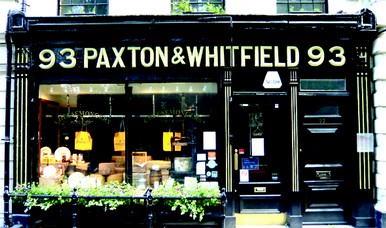 Paxton and Whitfield are cheesemongers, and have been since 1797. They navigated through a period of crisis about halfway through the Nineteenth Century, when the cheese coming from the continent was deemed more exotic and tasteful than that of the British factories, and during a period when small farmers seemed to prefer to sell their milk to the industry. Behind the pretty Victorian facade, beneath the sign that says “for exceptional cheese” there is a vast array of traditionally-made cheeses and cheesecakes. Here one can find Marlborough, Riviera, La Manche, and much more... There are delicate-tasting cheeses, those with a stronger twang to them, to which one can have walnuts or other dried fruit added, if one so desires...
Paxton and Whitfield are cheesemongers, and have been since 1797. They navigated through a period of crisis about halfway through the Nineteenth Century, when the cheese coming from the continent was deemed more exotic and tasteful than that of the British factories, and during a period when small farmers seemed to prefer to sell their milk to the industry. Behind the pretty Victorian facade, beneath the sign that says “for exceptional cheese” there is a vast array of traditionally-made cheeses and cheesecakes. Here one can find Marlborough, Riviera, La Manche, and much more... There are delicate-tasting cheeses, those with a stronger twang to them, to which one can have walnuts or other dried fruit added, if one so desires...After the war, the shop was expanded, and became a delicatessen, and therefore the choice of products is now even greater. Also the crackers (meant to be eaten with the cheese) are very tasty.
HAYMARKET
UNDERGROUND: PICCADILLY CIRCUS
It is often the case, especially with foreign names of places, that they are taken as a given fact, without a thought for the original meaning of the name. Today Haymarket, the street of theatres, which runs from Piccadilly Circus to Pall Mall, is an upper class neighbourhood, however its literal meaning tells another story. The reason for this name is that until 1830, in this area, forage for horses used to be sold. Carts filled with straw and hay would park along the sides of the main street and the forage would be sold without being subjected to duties. Also typical country products were sold here. On 29th June 2007, a car bomb was parked in this street. The police managed to intervene in time and disarm the bomb.
The Haymarket theatre was built in 1720 by the architect John Nash, on the area of an inn which was called King’s Head. It is the third oldest theatre of the metropolis to still be operational. It was also the first to launch the tradition of the matinee, in 1873. Many French operas were performed here, as well as satiric comedies, burlesque shows, and shows by Pasquin and Carey. The most famous comedies were brought on stage for the first time in 1893 and 1895. These were namely A Woman of No Importance and An Ideal Husband. by Oscar Wilde.
One of the theatre directors was the comedian John Sleeper Clarke, brother-in-law of John Wilkes Booth, who was also an actor, as well as being the murderer of President Lincoln. A short while after this deed took place, Clarke left his wife and moved to London.
THE MONUMENT FOR FLORENCE NIGHTINGALE
LOWER REGENT STREET
UNDERGROUND: TOWER HILL
In the place where the monument of Florence Nightingale stands today, there was once another one, formed by the statues of three royal guards, with an allegorical female figure representing Honour, designed by John Bell and officially presented in 1859. It was made with the bronze of cannons captured in the siege of Sevastopol. Then, in 1914, the monument was removed and moved to the corner of Lower Regent Street and Pall Mall, in order to make room for the statue of Nightingale and that of Sidney Herbert. The author of the latter, Arthur Walker, portrayed the nurse holding a lamp in her hand, something that formed the definition of her that was passed on to history. Nightingale is considered the founder of modern nursing healthcare, which follows a scientific method and was founded on the premises of clean air, pure water, an efficient sewage system, cleanliness, and lighting for the soldiers’ camps.
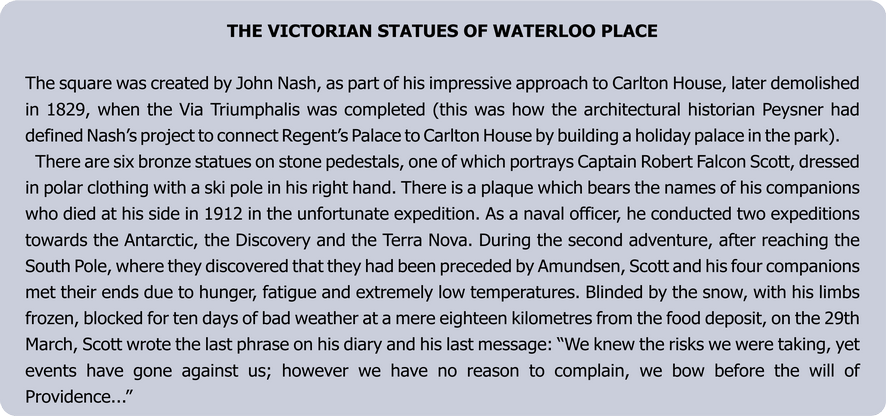
She left on 21st October 1854 for Istanbul, from where news had arrived about the terrible conditions in which the wounded were cared for, and there she suggested the organization of camp hospitals, where attention was also given to a correct diet. Nearby, there is a monument to the fallen of the Crimean war, where Nightingale developed her precious work.
CLUB ATHENAEUM
107, PALL MALL
UNDERGROUND: CHARING CROSS
The splendid building of the Athenaeum club, which overlooks Waterloo Place, was designed by Decimus Burton in 1824. The club had literary and scientific purposes, and was a gathering place for men involved in the fine Arts. The Dorian porch is surmounted by a great golden statue of Pallas Athena, the Greek goddess of wisdom.
Above the windows of the first floor, runs a frieze by John Henning, painted blue and white. Inside are the statues of Apollo, Venus, and Diana. Amongst its members, this club has included some of the greatest names in English literature, art, and science. Some of them are for example Joseph Conrad, Charles Dickens, Rudyard Kipling, John Ruskin, and Charles Darwin. There are sixty thousand volumes distributed on the shelves which cover the walls of the five rooms.
At first, a cap had been set at one thousand members. Then, through the years, the maintenance costs of the building and other factors made it necessary to increase the number of subscriptions. In 1838 forty members were admitted all at once, and were promptly nicknamed “the forty thieves”. Dickens and Darwin were among them. Fifty of the members of the Athenaeum have won Nobel prizes. Today the club has two thousand members, many of which are women. On Monday evenings conferences have been held since 1830.
TRAVELLERS’ CLUB
106 PALL MALL
UNDERGROUND: CHARING CROSS
The travellers club was founded in 1819 upon the suggestion of Castlereagh, at the time minister of Foreign Affairs. It was a meeting point for those who had travelled abroad and for foreign diplomats of the capital. In order to be admitted, however, aspiring English had to prove they had travelled abroad at least five hundred miles from London measured as the crow flies. The building was designed by Charles Barry, who for this project drew inspiration from the style of the Italian Renaissance. Today, in order to enter, one must be introduced by a member and have a great passion for travelling. The Italian members are around twenty in number.
The club has one of the most important geographical libraries, and the halls are adorned with marble reproductions of the temple of Apollo at Bassae.
At numbers 69-91, Pall Mall we find the Automobile Club, created in 1897, which throughout the years has organized many car and motorbike competitions. The building was designed by the French architect Mewès, who won the Prix de Rome in 1885, and also by his partner, Davis. It has a Turkish bath , a pool in Carrara marble, squash pitches, a snooker and pool room, and three restaurants. Some of the scenes from the film Where Eagles Dare were filmed here.
CARLTON HOUSE TERRACE
UNDERGROUND: PICCADILLY CIRCUS
The current buildings stand on the grounds of Carlton House, built in 1783 for the prince regent. However, as soon as the works ended, the prince was elected as king and moved to Buckingham Palace. In 1825, Carlton House was demolished. The paintings and furniture were moved to the royal home. Amongst them, there was a “prototype” of a desk, with thin legs, a leather surface, drawers to place paper in, and powder for blotting.
Carlton House Terrace is made up of two rows of elegant, majestic houses, with facades in white plaster. The buildings were built in 1832 following the design by John Nash, with the contribution of other architects, such as Decimus Burton. They have hosted illustrious characters and embassies. Today they host associations such as the Royal Society, the British Academy, the Institute of Contemporary Arts, the Photographic Department, and the archives of the National Portrait Gallery. During the Second World War, General De Gaulle and his staff lived in the building on the corner with Carlton Gardens.
GIRO’S GRAVE
9, CARLTON HOUSE TERRACE
UNDERGROUND: PICCADILLY CIRCUS
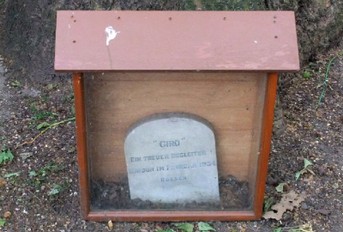 Through the gate at the top of the steps known as the Duke of York’s Steps, at the foot of a centuries-old tree, sits a box built in wood and glass. It protects the grave of a famous dog, called Giro. On the stone, there is an engraving in German: “Giro; ein treuer Begleiter!” (“Giro, a faithful companion”). The date 1934 and the name Hoesch are marked below.
Through the gate at the top of the steps known as the Duke of York’s Steps, at the foot of a centuries-old tree, sits a box built in wood and glass. It protects the grave of a famous dog, called Giro. On the stone, there is an engraving in German: “Giro; ein treuer Begleiter!” (“Giro, a faithful companion”). The date 1934 and the name Hoesch are marked below. Dr. Leopold Von Hoesch was the German ambassador in London from 1932 to 1936, and the engraving is in memory of his Alsatian, who died after running into a cable and getting electrocuted. This was the garden of the house at number 9 of Carlton House Terrace, the headquarters of the German embassy. Hoesch was the last ambassador of the Republic of Weimar, just before Hitler and the Nazis rose to power. Today the building hosts the Royal Society.
THE QUEEN’S GALLERY IN BUCKINGHAM PALACE
BUCKINGHAM PALACE
UNDERGROUND: VICTORIA
The Queen’s art gallery was opened to the public in 1962. There are rotating exhibitions of the works of art chosen from the royal collection, and especially those that belong personally to the Queen. There are almost always at least five hundred works exhibited. The gallery is situated in the western wing of the palace, where a chapel stands, that was bombed during the Second World War. In 2002, the gallery was renewed by the architect John Simpson, who added a Dorian porch at the entrance. The Queen then opened the inauguration ceremony herself. Something not to be missed, especially in the Summer is the garden, with its great variety of birds and wild flowers.
THE BUCKINGHAM PALACE MEWS
ROYAL MEWS
UNDERGROUND: VICTORIA
The royal mews that we see today were built upon the grounds of Buckingham Palace, near Grosvenor Place, in 1732. The word mew comes from the building where since 1377 the royal falcons were kept in the period of the moulting. In 1534, the building was destroyed by fire and rebuilt for keeping horses, but its name was not changed. The architect Nash rebuilt the royal mews, but they were modified and expanded subsequently. In fact, also the royal coaches are parked here. The most recent is the State Coach Britannia, weighing three tons, built in 2007 in Australia by Jim Frecklington and transported to London by plane to be donated to Queen Elizabeth II. The idea of the builder was to make a vehicle that incorporated the history of the English royal family and that of the United Kingdom. With this in mind, he used materials taken from historical buildings and ships. The crown on the roof, for example, is made with the beams of Nelson’s flagship. The handles are decorated with diamonds and sapphires. On the inside, there is air conditioning and the electric opening system of the windows is functional. One of the oldest is the Gold State Coach, built in Dublin in 1762 and used for the coronation of sovereigns.
The visit to the horses, all kept impeccably, exceedingly shiny and perfectly groomed, completes the tour pleasingly.
GREEN PARK
UNDERGROUND: GREEN PARK
Unlike other parks, Green Park does not contain small lakes, waterways, statues, nor monuments of any sort, but simply fields and areas with trees. Perhaps it is precisely because of the exclusive prevalence of green that one has the feeling of floating amid its fifty-three uninterrupted acres of fields and trees. Along with the park of Buckingham Palace and that of Kensington Gardens, Green Park forms a woody area which is almost uninterrupted from Whitehall to Notting Hill, and allows one to walk for kilometres through the green. It is strange to think that this was once a marshland, a place where lepers from the nearby hospital of St James were buried.
Along Queen’s Walk, the pedestrian street which outlines the eastern boundary, Queen Caroline, wife of King George II, had her own private library built within a small pavilion. From here one can admire the facades of Bridgewater House and Spencer House.
CANADA GATE
GREEN PARK
UNDERGROUND: GREEN PARK
Canada Gate, at the southern area of Green Park, is particularly beautiful. It was given by the state of Canada as a monument in memory of Queen Victoria, who died in 1901. It was designed by Aston Webb and carried out by Bromsgrove Guild in 1911. It is located on the route between Trafalgar Square and Buckingham Palace. It is built in wrought iron in black and gold hues, in the same style as the gates of Buckingham Palace. On the five portals there are stems and emblems corresponding to the seven provinces of Canada.
Inside the park, near the gate, there is a monument of red granite, sculpted by Pierre Granche, in memory of the thousands of Canadian soldiers who died in the war. It is a sloping square, divided in two by a sunken walkway. The two parts symbolize Great Britain and Canada, who fought alongside each other in both world wars. Bronze maple leaves, an emblem of Canada, have been inset into the sloping plane, and the water that runs over it, gives one the impression that the leaves are in fact floating on the water.
SPENCER HOUSE
27, ST JAMES’S PLACE
UNDERGROUND: GREEN PARK
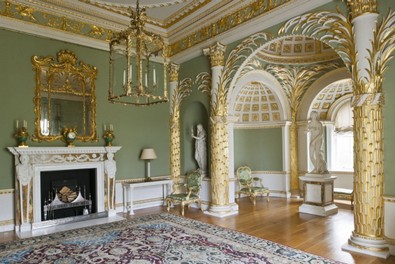 Spencer House is the palace of Lady Diana’s family. It was commissioned by the first count of Spencer to the architect Vardy in 1756. It is one of the few buildings of the epoch to have survived. Vardy designed the facades that we still see today, then in 1758, he was replaced by James Stuart, who had studied Greek architecture and was therefore so enthusiastic that he was nicknamed Athenian. The result was that the inside area, used for receptions and entertainment, has a great deal of detail in a perfect Palladian Neoclassical style. There is, however, a room on the ground floor which is entirely the work of Vardy, namely the Palm Room, where men would retire after dinner. The pillars, dressed in gold, have been sculpted to resemble palm trunks, upon which leaves stand out. The frieze, also in relief and golden, portrays gryphons and candle holders and was inspired by the Roman temple of Antonino and Faustina. The architect who substituted Vardy was instead fascinated and charmed by the Pompeii style, by the great scenic richness of those paintings, the ochre squaring, the fantastical architecture, the imitations of marble covering, the trompe l’oeil, the scenes which were sometimes tragic and at other times comical, the landscapes, the rich ornamentation with winged figures, and the mythological fables... and thus, at Spencer House, he recreated a room in pure Pompeian style. The palace remained uninhabited for a long time and was abandoned by the Spencer family. Then, under the initiative of a Rotchild, the building was restored, used as a series of offices as well as for reception events. A visit to this splendid eighteenth-century palace is an enjoyable way to end a walk through Green Park. The extraordinary front garden, with flowers and bushes that change appearance with the passing of seasons, is almost an extension of the park.
Spencer House is the palace of Lady Diana’s family. It was commissioned by the first count of Spencer to the architect Vardy in 1756. It is one of the few buildings of the epoch to have survived. Vardy designed the facades that we still see today, then in 1758, he was replaced by James Stuart, who had studied Greek architecture and was therefore so enthusiastic that he was nicknamed Athenian. The result was that the inside area, used for receptions and entertainment, has a great deal of detail in a perfect Palladian Neoclassical style. There is, however, a room on the ground floor which is entirely the work of Vardy, namely the Palm Room, where men would retire after dinner. The pillars, dressed in gold, have been sculpted to resemble palm trunks, upon which leaves stand out. The frieze, also in relief and golden, portrays gryphons and candle holders and was inspired by the Roman temple of Antonino and Faustina. The architect who substituted Vardy was instead fascinated and charmed by the Pompeii style, by the great scenic richness of those paintings, the ochre squaring, the fantastical architecture, the imitations of marble covering, the trompe l’oeil, the scenes which were sometimes tragic and at other times comical, the landscapes, the rich ornamentation with winged figures, and the mythological fables... and thus, at Spencer House, he recreated a room in pure Pompeian style. The palace remained uninhabited for a long time and was abandoned by the Spencer family. Then, under the initiative of a Rotchild, the building was restored, used as a series of offices as well as for reception events. A visit to this splendid eighteenth-century palace is an enjoyable way to end a walk through Green Park. The extraordinary front garden, with flowers and bushes that change appearance with the passing of seasons, is almost an extension of the park. 
